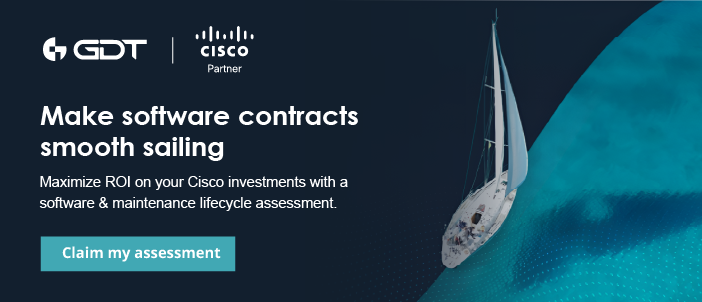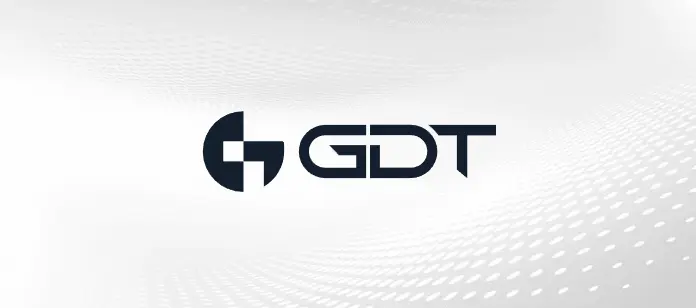It started with an invoice they didn’t expect—$280,000 in unbudgeted costs tied to licenses they didn’t even know they were overusing. That was the moment this healthcare provider realized how important Cisco True Forward visibility really is. And they’re not alone.
For organizations that rely on Cisco to power critical parts of their infrastructure, enterprise agreements (EAs) offer a streamlined path to managing licensing, gaining flexibility, and supporting growth. But while the benefits are clear, many companies encounter unexpected challenges—especially when it comes to one feature in particular: the Cisco True Forward.
Cisco’s True Forward process is designed to simplify software growth and eliminate the need for retroactive license billing. But without proper management, it can become a budgetary blind spot. GDT has helped hundreds of clients get ahead of these issues through planning, visibility, and expert asset lifecycle management and support. Here are the steps we take to help clients avoid the trap—and turn what’s often a source of stress into a strategic advantage.
Why Cisco True Forward costs can blindside you
True Forward is Cisco’s method of reconciling license consumption within an EA. If you deploy more licenses than your EA entitlement includes, Cisco reviews that overage annually and applies a cost adjustment moving forward. You’re not billed retroactively—but you are billed for the additional consumption on a go-forward basis, based on the remainder of the term.
That process may sound fair on the surface. But for many organizations, Cisco True Forward charges arrive without warning—typically during a mid-year or end-of-year cycle, and outside of procurement’s planning window. These charges often aren’t small either. With decentralized teams and evolving infrastructure needs, it’s easy to unintentionally deploy more licenses than planned—especially without tools or expertise in place to monitor usage consistently.

5 ways GDT keeps clients in control through asset lifecycle management
What makes GDT different is that we don’t treat license renewals or Cisco enterprise agreement activations as transactional milestones. Instead, we embed asset lifecycle management strategy at the heart of every agreement we support. For True Forward, in particular, we take a proactive and hands-on approach built around five key components.
1. Conduct a Software & Maintenance Lifecycle Assessment before the agreement
We begin by analyzing the client’s current environment before an EA ever goes live. Our Software & Maintenance Lifecycle Assessment identifies opportunities to consolidate support contracts, eliminate redundant spend, and flag EA-eligible software that’s already deployed. This isn’t a surface-level review—it’s a data-driven analysis that gives our clients and us a clear understanding of where True Forward risk might emerge before it becomes a cost.
2. Structured onboarding and smart account optimization
Once the EA is in motion, we don’t leave clients to manage it alone. Our dedicated customer success managers and technical specialists lead onboarding sessions to review Smart Account structure, license alignment, and administrative setup. We help clients configure virtual accounts, roles, and permissions the right way—so usage data is accurate and accessible from the start.
3. Real-time license monitoring with GDTamp
Visibility is the single most important tool in managing a Cisco enterprise agreement. That’s why every client receives access to GDTamp, our proprietary asset management platform. GDTamp pulls real-time consumption data directly from Cisco and visualizes it through clean, intuitive dashboards. Our clients use it to track entitlements, monitor active use, and forecast potential Cisco True Forward charges months in advance.
4. Forecasting and value shift optimization
Our team models license growth and usage patterns on a rolling basis, giving clients a forward-looking view of how consumption trends could impact future billing. When growth does occur, we guide clients through Cisco’s Value Shift mechanisms, which allow them to transfer unused license value within or across eligible EA suites. This can dramatically reduce or even eliminate a Cisco True Forward charge, but it requires precise timing and a deep understanding of EA mechanics.
5. Quarterly business reviews and ongoing adjustments
We don’t show up once a year. Every GDT EA customer receives quarterly reviews that include updated license health reports, True Forward risk projections, and actionable recommendations. These conversations keep IT, procurement, and business leadership aligned—and ensure there are no surprises when Cisco performs its next usage review.
A real-life example: When visibility made the difference
One of GDT’s clients, a global healthcare provider, was hit with a $280,000 surprise True Forward bill. They had unintentionally exceeded their Meraki license entitlements across multiple business units, and internal teams had no way to detect the issue in time.
We stepped in immediately. After reviewing their Smart Account structure and license deployment history, we discovered underutilized entitlements in their DNA Switching suite—licenses that hadn’t been touched but held substantial residual value. Using Cisco’s Cross Suite Value Shift, we were able to apply that value toward their Meraki overage. The result: $190,000 of the charge was offset, and the final invoice was reduced by more than two-thirds.
We didn’t stop there. We worked with their IT and procurement leaders to restructure their Smart Account, establish better license ownership controls, and train their internal admins on best practices moving forward. The changes not only resolved the immediate problem—they gave the organization a long-term path to manage their EA with confidence.
Make Cisco True Forward work for you
GDT is more than a Cisco reseller—we are one of the few organizations globally recognized for our lifecycle management leadership. GDT software and support services experts help businesses unlock hidden potential, drive IT budget optimization, and achieve better business outcomes. From onboarding and Smart Account strategy to quarterly reviews and True Forward modeling to software asset management, we help clients stay in front of their software investments—not behind them.
If your organization is planning a Cisco EA or already has one in place, now is the time to ensure you’re protected. Schedule a Software & Maintenance Lifecycle Assessment with GDT and see how our team can help you reduce risk, control spend, and drive real outcomes from your Cisco enterprise agreement.



